 Research Article
Research Article
Thermal Comfort Analysis of Moisture Management Treated Cotton Fabrics for Sportwear
Dahua Shou*
Institute of Textiles and Clothing, The Hong Kong Polytechnic University, Hong Kong, China
Dahua Shou, Institute of Textiles and Clothing, The Hong Kong Polytechnic University, Hung Hom, Kowloon, Hong Kong, China.
Received Date: June 21, 2021; Published Date: June 29, 2021
Abstract
The COVID-19 pandemic has posed great challenges to the learning and teaching in universities. While addressing this crisis, the teachers and students have recognized the coexistence of the challenge and opportunity. The pandemic has not only changed education dramatically, with the distinctive rise of e-learning and remote teaching, but also brings the latest fashion technologies such as intelligent wearables and advanced textiles to citizens including the university students. Following this trend, we provide a case study in fashion and wearable technology subjects by putting the COVID-19 in a context of teaching and learning. We have proposed varied assignments and encourage students to work on teamwork and group projects related to the COVID-19. Particularly, development of a wearable cooling mask is demonstrated and discussed as a study case, which has significantly improved interest of the students and their understanding of knowledge in fashion technologies.
Keywords:Teaching and Learning; Wearable Technologies; Cooling Mask; COVID-19
Introduction
There is no doubt that the on-going COVID-19 pandemic has significant impact on all the communities globally [1]. It is critical for all the educators to respond positively and properly on the teaching, which will influence the future of the society. The sudden shift to the online teaching and learning or the mixed mode of online and face-to-face learning has inevitably highlighted existing inequalities in education. Many teachers and students have insufficient knowledge and experience of online education. Moreover, the students are from various areas, with a huge deviation in computers, internets, and even environments, and the new gaps have been created between different learners [2]. Despite of challenges in communication and the accompanied regression in learning environment, we should continue our courses and teach all students fairly without decreasing the learning outcome and quality.
The COVID-19 has reshaped the learning and teaching activities dramatically [3]. It has been shown that the students can retain 25- 60% more material when learning online, in comparison to 8-10% in a classroom. It indicates the faster learning online as the students can pre-read, skip and accelerate through certain concepts and the e-learning facilitates self-learning at the students’ own pace [4]. However, the effectiveness of online learning and teaching varies amongst different groups. Many students can be easily distracted during online classes and the teachers cannot effectively monitor whether the students have grasped the concepts and knowledge. As such, utilization of a range of collaboration tools and engagement methods are highly desirable.
Every coin has two sides, and the increasing interaction between all individuals and the COVID-19, such as wearing a mask, has brought new learning opportunities and sources based on the first-hand experience, emerging technologies, and common interest. The latest technologies such as 3D printing [5,6], artificial intelligence [7], wearable electronics [8], virtual reality [9], and advanced materials [10] have been driving the next evolution of smart manufacturing and digital technologies in textile and fashion industry. To this end, we will put the COVID-19 in a context of teaching and learning, providing a case study in fashion and wearable technology subjects by solving the problems of common interest and experience of the students. We have proposed varied assignments and encourage students to work on teamwork and group projects (e.g., smart wearable masks and healthcare protective garments) related to the COVID-19, solving the emerging problems based on the latest technologies.
Method
It is crucial to instruct students to understand the fundamental knowledge and broad context of the course. In the age of COVID-19, the teachers must put themselves in students’ shoes.
Students don’t learn when teachers simply repeat the contents in the textbook, especially in an online mode; instead the teachers should endeavor to relate theory to the latest practical problems that are familiar by the students, motivating the need for recalling the right information to come up with solutions. To this end, we create and assign interdisciplinary term projects ranging from smart mask to protective garments by introducing the latest fashion technologies including smart wearables, advanced textiles, and artificial intelligence. The proposed projects have clear expected outcomes such as improving comfort and protection of the fashion product, so that students will improve their knowledge during their pursuit of solutions to problems.
Students’ ability to impart knowledge to others is an important criterion of successful teaching. The students are encouraged to regularly communicate with different types of people, following the social distancing policy in the age of COVID-19. They should be able not only to debate subject matter with peers or experts in the field, but also to present the ideas smoothly with non-experts, using simple and concise language. It is noted that various online challenges have been faced by the students during their presentation and discussion. For example, some students are not well equipped with a high internet connection and they face problems in going live for virtual presentation. As such, the students are asked to conduct mock presentations to team members before the formal ones and they should consider the online risk management as an essential skill in future.
I encourage students to develop their own knowledge tree across different disciplines. A clear picture of the connection between different facets of knowledge will deepen their understanding and help them to improve their communication of subject matter. Fashion and wearable technology subjects are a collection of interesting stories of fashion, textiles, design, engineering, marketing, and so forth. From these stories, the students are asked about the ‘how’ and ‘why’, so that they can promote intellectual thinking after discussion with peers in groups. Besides, the big picture also includes insight, communication skills, and problem-solving skills.
Traditionally, teachers are considered as the center of learning and teaching, while students need to listen and take the notes. However, the learning and teaching in the COVID-19 time will require the students to take the initiative for their own learning, becoming the main body of the education process. To this end, I will often ask the students to review and evaluate the current masks and summary the advantages and disadvantages when addressing the case study on masks.
Currently, they are quite familiar with the masks and can always provide the first-hand using experience. Moreover, they are willing to work on the project to improve the performance of mask by realizing their significance and necessity. Based on the active learning and preliminary research, the students will understand the knowledge more comprehensively after I introduce the fabrication process and raw materials as well as the standard testing methods.
In the subject of fashion technology, the objectives are often firstly highlighted, including awareness of present and emerging technologies available in the fashion and textiles industry, and firsthand experience of the latest technologies and real-life industrial practice, in response to the changing demands of the fashion industry. The learning outcomes are also introduced in detail to the students, that they will be able to assess recent garment processing technologies and developments in response to the changing needs of the fashion industry, demonstrate awareness of the latest fashion technologies and innovations and integrate into the process of fashion design and development, develop product to conform to performance requirements and professional standards, and gain sustainable competitive advantages in the marketplace.
In particular, a suggested frame of development of a fashion technology has been given as follows, and all the steps can be conducted based on an online teaching and learning mode.
• Market and trend analysis
• Analysis of existing products and end users’ requirements
• Idea generation
• Product specifications
• Product design (fashion and technical design)
• Prototype development
• Product evaluation
• Product modification and optimization
• Production (Vendor selection & standardization)
Here, the market and fashion trends should be comprehensively analyzed, which can include economic trends (how much people can afford? growth rate, employment, education, housing, and interest rate can be concerned), industry trends (how are we doing? products, sales, jobs, new technology, leading companies, and government policy can be concerned), consumer groups (the needs from consumers? the age, race, education, and house hold can be concerned), and fashion trends (the new style, color, fibers, and fabric can be concerned).
It is critical to determine the end-use requirements, which generally include comfort, aesthetics, durability, handle, workmanship, aftercare, and additional functionalities for the fashion technologies. In the age of COVID-19, the functions of protection, healthcare, and comfort are of extraordinary significance. The right evaluation methods will be carefully selected to validate the innovation, effectiveness and feasibility of the proposed fashion and wearable technology.
The students are encouraged to generate ideas freely. The brainstorms can always lead to fantastic design strategies, but the students should also concern the practical market and fashion trends and the technological capacity. Group discussion is helpful to address the end use requirements of the targeted product completely based on personal experience and perception from various students, and the shortcomings of existing products should be summarized accordingly.
Case Study of Wearable Cooling Mask
Background and motivation
Filtering facepiece respirators have become daily necessities for the public as COVID-19 has exploded around the world. Disposable surgical masks designed to prevent infections in patients by filtering bacteria shed in aerosols or liquid droplets from the wearer’s mouth and nose, have been widely utilized to block the spread of COVID-19. They can create a physical barrier to protect the wearer and reduce the risk of infection in polluted air and potentially contaminated environments. Based on GlobeNewswire, the global mask market increases significantly from USD 737 million in 2019 to USD 22 billion in 2021.
Despite their protection and insulation from toxic particles and viruses, masks cause thick humid air and soaring temperatures that can lead to breathing difficulties and discomfort for a number of people (Figure 1). The hot and humid environment in tropical regimes such as Hong Kong or in a summer season can further increase the elevated risk of heat illnesses including heat stroke and heat exhaustion. A wet and soaked mask due to excess perspiration and condensation from the warm and moist air in the microclimate between face and mask can be quite uncomfortable and more liable to virus penetration. Moreover, current surgical masks often do not fit the wearer’s face due to their loose fit design and the mask can be contacted and wetted by the wearer’s mouth.
Use of the masks described above is not suitable for wearers without consideration of the heat and moisture management properties in the practical environment and personal conditions. Moreover, they cannot cool wearers in extremely hot and humid environments such as Hong Kong, especially in summer. To this end, a cooling mask that can regulates the temperature is highly desirable, which is chosen as the present study case.

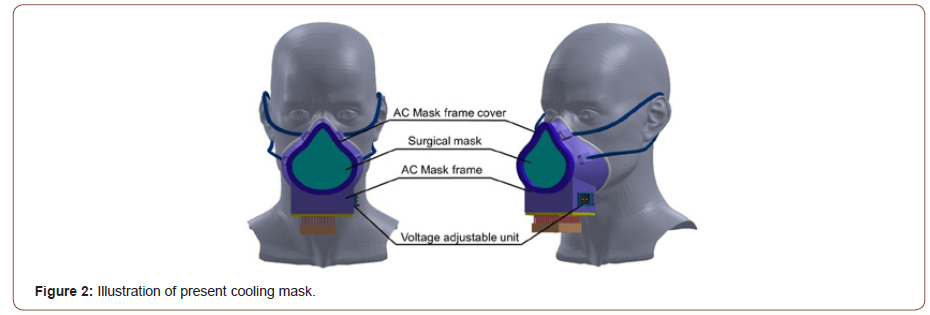
Product development
A temperature controllable cooling mask protecting you from unpleasant heat and high humidity inside the facepiece has been proposed. The illustration of the cooling mask is shown in Figure 2. The mask frame is integrated with a thermoelectric system and a disposable surgical mask, enabling control of temperature and airflow. In particular, the thermoelectric system is placed at the bottom of the air-conditioned mask frame, such that the supplied cooling air is blown from the lower side, reducing the temperature and humidity of the wearer’s breathed air (Figure 3). The mask frame is a 3D design, providing sufficient space for easy breathing and air ventilation. As well, it prevents contact of both mouth and nose with the disposable mask. Soft and comfortable siliconesealed mask frame has also been designed for high protection of the wearer from external particles and virus.
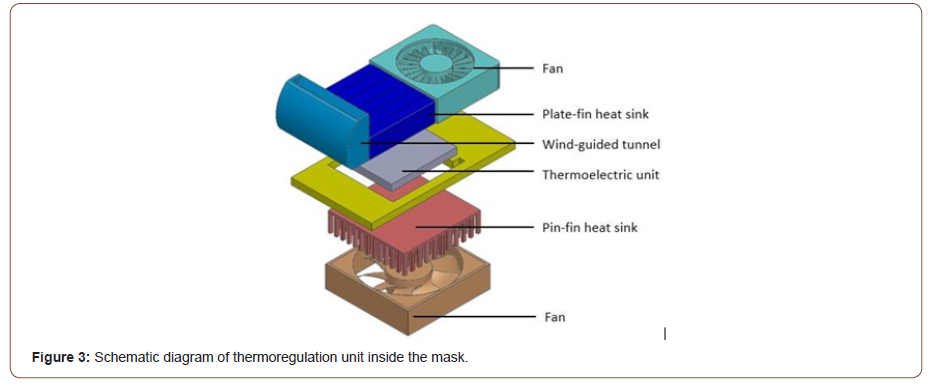
Comprehensive tests and evaluation have been conducted to demonstrate the cooling effect and temperature management property. The homemade setup of temperature measurement with the cooling mask attached to a human head model is shown in Figure 4. It is noted that the air temperature can be controlled by a low voltage, dropping by up to 12 ∘C (Figure 5). As well, the temperature has been significantly reduced when wearing the proposed cooling in comparison to a conventional mask, as seen in the thermal image of the human test (Figure 6).
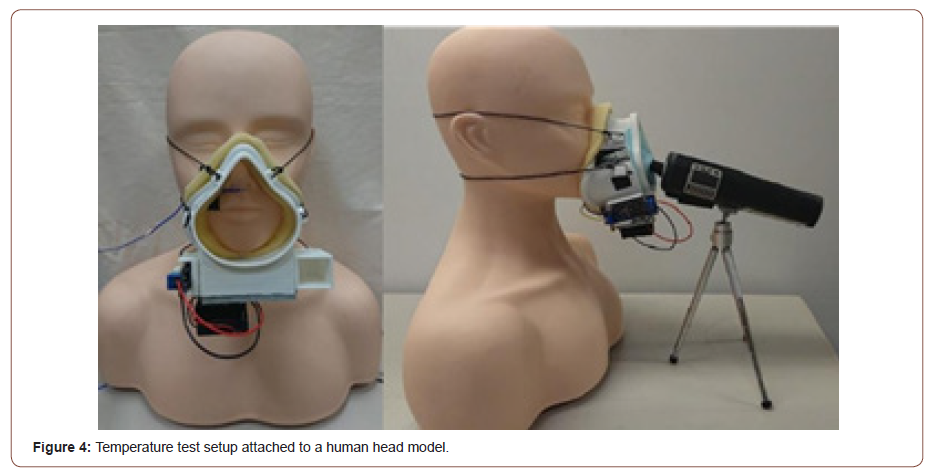
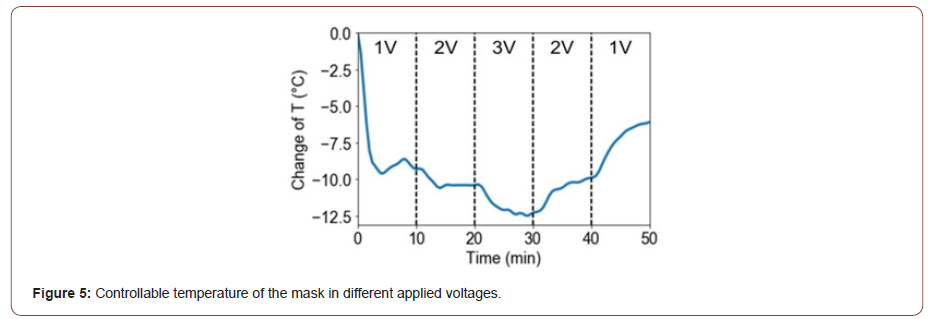
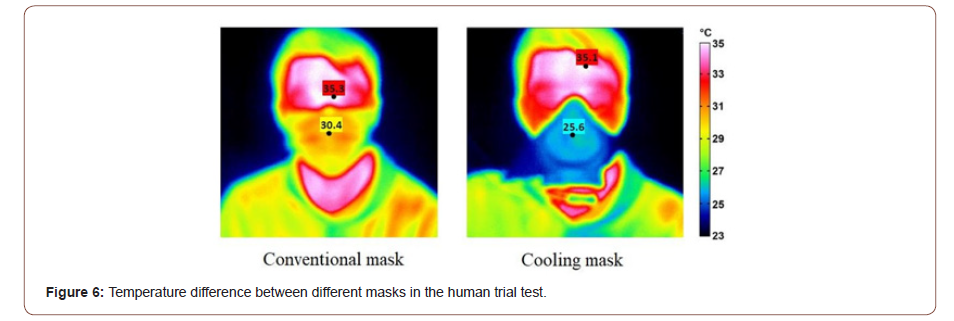
Conclusion
We have shown a case study of teaching and learning in fashion technology subjects in the age of COVID-19. Despite of various challenges, we proposed the assignments related to the COVID-19 and encourage the students to work on teamwork and group projects by solving the practical problems using the latest technologies such as smart wearables. The development of a wearable cooling mask has been successfully implemented, and the derived outcome and experience will advance the knowledge in fashion technologies and inspire the students to learn actively and effectively in a new mode.
Acknowledgement
The author acknowledges the Departmental General Research Fund (Project Number: BE1F and UAMA) from The Hong Kong Polytechnic University.
Conflict of Interest
Author declare no conflict of interest.
References
- Ibn-Mohammed T, Mustapha KB, Godsell J, Adamu Z, Babatunde KA, et al. (2020) A critical review of the impacts of COVID-19 on the global economy and ecosystems and opportunities for circular economy strategies. Resources, Conservation and Recycling 164: 105169.
- Khlaif ZN, Salha S, Fareed S, Rashed H (2021) The hidden shadow of Coronavirus on education in developing countries. Online Learning 25 (1): 269-85.
- El Said, Ghada Refaat (2021) How Did the COVID-19 Pandemic Affect Higher Education Learning Experience? An Empirical Investigation of Learners’ Academic Performance at a University in a Developing Country. Advances in Human-Computer Interaction.
- Darling-Hammond L, Flook L, Cook-Harvey C, Baron B, Osher D (2020) Implications for educational practice of the science of learning and development. Applied Developmental Science 24(2): 97-140.
- Kim S, Seong H, Her Y, Chun J (2019) A study of the development and improvement of fashion products using a FDM type 3D printer. Fashion and Textiles 6: 9.
- Kwon YM, Lee YA, Kim SJ (2017) Case study on 3D printing education in fashion design coursework. Fashion and Textiles 4: 26.
- Papachristou E, Chrysopoulos A, Bilalis N (2020) Machine learning for clothing manufacture as a mean to respond quicker and better to the demands of clothing brands: a Greek case study. International Journal of Advanced Manufacturing Technology: 12.
- Singha K, Kumar J, Pandit P (2019) Recent Advancements in Wearable & Smart Textiles: An Overview. Materials Today-Proceedings 16(3): 1518-1523.
- Park M, Im H, Kim DY (2018) Feasibility and user experience of virtual reality fashion stores. Fashion and Textiles 5: 32.
- Shou D, Fan J (2018) An all hydrophilic fluid diode for unidirectional flow in porous systems. Advanced Functional Materials 28(36): 1800269.
-
Dahua Shou. Teaching and Learning in Subjects of Fashion Technology in the Age of COVID-19. 8(4): 2021. JTSFT. MS.ID.000694.
-
Active senior, Safari jacket design, Product development, Retailers, Apparel, Consumption growth, Fashion market
-

This work is licensed under a Creative Commons Attribution-NonCommercial 4.0 International License.






